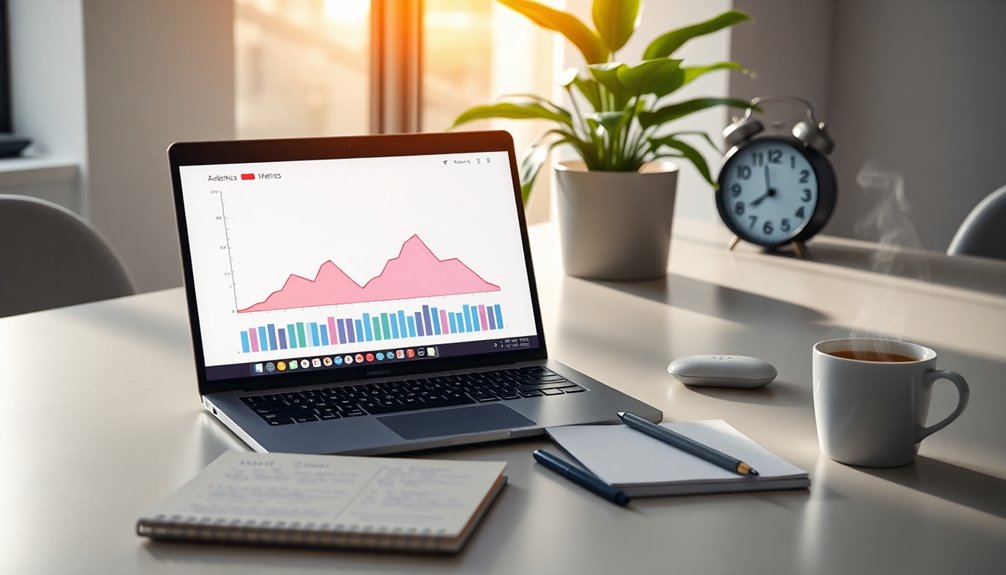If your Google Ads are underperforming, start by pinpointing when the decline began. Check your historical data and see what's changed in your campaigns or keywords. Improve your ad rank by optimizing your ad relevance and landing pages. Regularly refresh your ad creatives to combat fatigue and maintain engagement. Don't forget to analyze your keywords; pause those that underperform and explore long-tail options. Ultimately, utilize analytics tools to track performance and gain insights. There's more effective strategies to elevate your campaigns waiting for you to discover.
Key Takeaways
- Identify the exact date of performance decline by analyzing historical data and recent performance reports to pinpoint issues.
- Improve Ad Rank by enhancing ad relevance through targeted keywords, effective ad copy, and optimizing the landing page experience.
- Refresh ad creatives regularly to combat ad fatigue with new visuals, compelling CTAs, and dynamic content.
- Optimize keywords by pausing underperforming ones and incorporating long-tail keywords for more focused traffic.
- Utilize analytics tools to track performance metrics, automate reporting, and gain insights for continuous improvement.
Identify the Decline's Start

When you notice a decline in your Google Ads performance, it's crucial to identify when the drop started. Start by diving into your historical data to pinpoint the exact date of the decline.
Check your weekly or daily performance reports over the last 30 days to see if you can find any significant fluctuations. Analyze specific campaigns, ad groups, and keywords to uncover which elements might be contributing to the issue.
Look for trends or patterns that could indicate the cause of the decline. Additionally, compare performance metrics like click-through rates (CTR) and conversion rates to spot any significant changes. This analysis will give you a clearer picture of what's affecting your ads.
Be aware that changes to your landing page can disrupt ad-to-landing page cohesion, leading to lower Quality Scores and reduced performance.
Analyze Ad Rank and Quality

To improve your Google Ads performance, analyzing Ad Rank and Quality is essential.
Start by understanding the key factors affecting Ad Rank, like your maximum CPC, search relevance, ad format, landing page experience, and expected click-through rate (CTR).
Focus on improving ad relevance by targeting the right keywords, crafting compelling ad copy, and organizing ad groups effectively. Additionally, a high Ad Rank can lead to better ad placements, which directly correlates with increased user clicks.
Utilize ad extensions to boost visibility as well.
Enhance the landing page experience by ensuring fast load speeds and mobile-friendliness.
Monitor your Quality Score regularly, as it reflects your landing page experience, expected CTR, and ad relevance.
Finally, be aware of the competitive landscape and adjust bids accordingly to maintain a favorable Ad Rank.
Refresh Ad Creatives

Revitalizing your ad creatives is essential for maintaining engagement and driving conversions. Start by changing visuals regularly; update images and videos to keep your ads new. Short-form video ads can particularly capture attention, so consider shifting from static images to video formats. Experiment with various color schemes and unique visual trends to stand out from competitors. Don't forget to test different calls-to-action (CTAs)—clear, actionable buttons can greatly boost conversions. Rotate ads with different imagery and CTAs to prevent ad fatigue. Finally, automate ad refreshes using tools like Dynamic Creative Optimization to personalize content based on user behavior. By consistently renewing your creatives, you'll keep your audience interested and enthusiastic to engage. Additionally, major brands rotate creatives every 10.4 days on average, making frequent updates essential for optimal performance.
Optimize Your Keywords

Optimizing your keywords is essential if you want to improve the performance of your Google Ads campaigns. Start by identifying underperforming keywords with low-quality scores, high cost per conversion, and low conversion rates. Check their search volume and ad rank to pinpoint issues. Diagnose problems by analyzing keyword match types and using the search terms report to weed out irrelevant keywords. Consider monitoring competitor keywords for new opportunities. Implement optimizations by pausing irrelevant keywords, adding new relevant ones, and experimenting with different match types. Including long-tail keywords to attract targeted traffic is crucial, as they often have higher search volume and create single keyword ad groups for better control. Regularly track performance and adjust your keyword list based on data to maximize your ad effectiveness.
Utilize Analytics Tools

How can you truly elevate your Google Ads performance? Utilizing analytics tools is key.
Start with Google Ads Editor, which is free and allows you to track KPIs like conversions and click-through rates. Its integration with Google Sheets makes data analysis a breeze.
For detailed insights, SegmentStream automates reporting and uses machine learning to predict conversions without relying on cookies.
Google Analytics offers custom reporting and demographic insights, helping you tailor your strategies.
Vaizle's Google Ads Analyzer provides a user-friendly dashboard for tracking performance without any credit card required. This tool simplifies data extraction into a visually appealing dashboard, making it easier to understand your ad performance at a glance.
Finally, leverage Google Ads Performance Grader Plus for instant reports and competitive analysis, ensuring you're always optimizing your campaigns effectively.
Frequently Asked Questions
How Can I Increase My Overall Google Ads Budget Effectively?
To effectively increase your overall Google Ads budget, start by setting clear goals for your campaigns.
Research industry benchmarks to determine a competitive yet realistic budget.
Allocate funds to higher-performing campaigns and regularly monitor their performance.
Consider implementing automated scripts to manage budget pacing and adjustments.
What Is the Ideal Frequency for Reviewing My Ad Performance?
Did you know that businesses that regularly review their ad performance see a 30% increase in ROI?
To maximize your results, you should monitor daily for immediate issues, analyze weekly for long-term trends, conduct monthly audits for thorough reviews, and perform quarterly evaluations to align with your business strategy.
This structured approach keeps your campaigns responsive, relevant, and optimized, ensuring you stay ahead in a competitive landscape.
How Do Seasonal Trends Impact Google Ads Performance?
Seasonal trends considerably impact your Google Ads performance. You should identify key seasons when demand peaks for your products or services.
Analyze historical sales data to understand these trends better. Adjust your campaigns by timing your launches early and allocating budgets wisely.
Use seasonal messaging in your ads to resonate with consumers. By leveraging insights from Google Trends, you can optimize your targeting and improve your ad performance throughout the changing seasons.
Can I Automate Google Ads Optimizations for Better Results?
You can absolutely automate Google Ads optimizations for better results.
For instance, imagine a travel agency using Performance Max campaigns to reach potential customers across various platforms. By leveraging automation, they can adjust bids in real-time based on user behavior, enhancing their ad performance greatly.
Automating ad testing helps identify the best-performing ads, while machine learning can predict cost-effective bids, ultimately saving you time and driving higher conversions.
What Common Mistakes Should I Avoid in Google Ads Management?
When managing Google Ads, avoid common mistakes like using broad match keywords that attract irrelevant clicks.
Make certain you align campaign settings with your business goals and maintain consistent ad scheduling.
Don't neglect landing page optimization—make sure it's relevant, loads quickly, and is mobile-friendly.
Be mindful of budget management; allocate funds based on performance.
Finally, don't rely solely on automated solutions; review changes to maintain control over your campaigns.
Conclusion
If your Google Ads are underperforming, don't worry; you can turn things around faster than a lightning bolt! By pinpointing when the decline started, analyzing your ad rank and quality, revitalizing your creatives, optimizing keywords, and utilizing analytics tools, you'll see improvements in no time. Remember, staying proactive and making small adjustments can lead to monumental changes in your campaign's success. So, roll up your sleeves and get ready to boost those ads!









